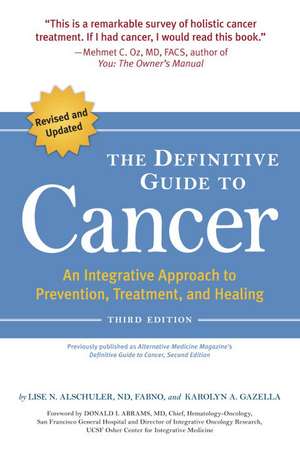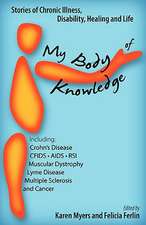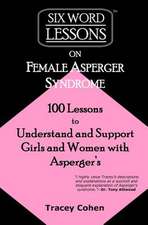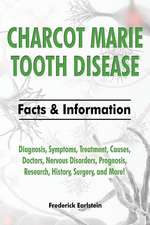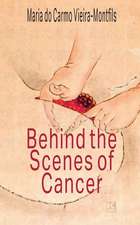The Definitive Guide to Cancer: An Integrative Approach to Prevention, Treatment, and Healing
Autor Karolyn A. Gazella, Lise Alschuleren Limba Engleză Paperback – 31 mar 2010
Preț: 204.69 lei
Nou
Puncte Express: 307
Preț estimativ în valută:
39.18€ • 42.57$ • 32.93£
39.18€ • 42.57$ • 32.93£
Carte disponibilă
Livrare economică 31 martie-14 aprilie
Preluare comenzi: 021 569.72.76
Specificații
ISBN-13: 9781587613586
ISBN-10: 1587613581
Pagini: 496
Ilustrații: ONE COLOR
Dimensiuni: 161 x 229 x 36 mm
Greutate: 0.77 kg
Ediția:3 Rev ed.
Editura: CELESTIAL ARTS
ISBN-10: 1587613581
Pagini: 496
Ilustrații: ONE COLOR
Dimensiuni: 161 x 229 x 36 mm
Greutate: 0.77 kg
Ediția:3 Rev ed.
Editura: CELESTIAL ARTS
Notă biografică
LISE N. ALSCHULER, ND, FABNO, is a naturopathic physician with widely recognized expertise as a speaker, author, and practitioner of integrative medicine.
KAROLYN A. GAZELLA is an accomplished author, health writer, and publisher of the Natural Medicine Journal.
KAROLYN A. GAZELLA is an accomplished author, health writer, and publisher of the Natural Medicine Journal.
Extras
The Cancer Experience
Cancer results from the uncontrolled growth of abnormal cells. As these cells continue to divide, they form into cancerous tumors. With destructive precision, a cancerous tumor redirects blood flow to itself as it leaches off its healthy cellular neighbors. Cancer cells can invade other tissues within the body and produce additional tumors. The frenzied development of a cancerous tumor can overwhelm the organ or tissue where it is located. Left unchecked, many cancers can eventually destroy enough tissue that the body loses its ability to sustain life.
This monstrous demolition can be mirrored emotionally in the person with cancer. The physical chaos and damage is only a part of the story. Cancer brings with it thundering amounts of anger, anxiety, or fear, which can render someone less able to cope emotionally. Even for the most stoic of souls, three simple words--“you have cancer”-- can create a simmering internal panic. This panic can be both reflected and magnified in loved ones. A cancer diagnosis goes well beyond the patient, and takes its toll on loving family and friends as well. Sometimes it can be even more difficult being a caregiver or support person and watching a loved one struggle.
Although a cancer diagnosis can bring on a fear of dying, cancer is not a death sentence. That may be difficult to believe if you are in the throes of a recent diagnosis or struggling with treatment. However, not all people diagnosed with cancer physically succumb to the disease. And even among those who do die from cancer-related causes, there are some who experience tremendous wellness and healing in the process. Cancer offers an opportunity for deep reflection and introspection, no matter what the outcome of the disease. It helps us consider the whole of life rather than the sum of its material parts.
Coping with cancer requires us to first embrace it. After it shakes us to our very core, we concede the emotional storm it has created. During a conversation with mind-body-spirit pioneer Rachel Naomi Remen, MD, who has worked with thousands of cancer patients, she explained that ignoring fear can prevent us from healing. She recommends that people with cancer invite it in. “Although it is expressed in a very constricting way, fear is the will to live. What’s under the fear is a desire for life, and we need to somehow get to that. That means going through the fear, not denying it.” Discovering our inner strength enables us to face the unknowns associated with a cancer diagnosis. Over the years, Dr. Remen has found that “the experience [of having cancer] can be transformative.”
For both patients and their loving supporters, this will be a highly individualized and personal process. There is no right way to cope with cancer. Whether you are the one with the diagnosis or a loved one is, you will want to patiently take one step at a time.
The first step is to understand what cancer is.
Cancer Defined
Technically, cancer is not one disease. It is a complex illness with more than 200 variations. A cancer malignancy is characterized as a locally invasive and destructive growth pattern caused by the development of genetically altered cells. The cancer is typically designated based on the organ it originates in. There are five major types of cancer:
• Carcinomas, the most common type of cancerous growth, are solid tumors that may affect almost any organ or part of the body. They can spread to other parts of the body via the lymphatic fluid or the bloodstream. Carcinomas may occur in the skin, mouth, nose, throat, lungs, genitourinary and gastrointestinal tracts, and glands, such as the breasts or thyroid.
• Leukemias form in the blood and bone marrow and are not solid tumors. The abnormal white blood cells associated with leukemias replace healthy white blood cells and circulate throughout the bloodstream.
• Myelomas are tumors that originate in bone marrow plasma cells, the antibody-producing white blood cells. Myelomas were formerly considered rare, but their incidence is increasing.
• Lymphomas are cancers found in the glands and nodes of the lymphatic system. Lymph nodes are the body’s filtering system, helping to remove toxins and impurities. These small, round masses of tissue are concentrated in the neck, groin, armpits, spleen, center of the chest, and around the intestines. Lymphomas are solid tumors usually made up of abnormal white blood cells. Hodgkin’s and non-Hodgkin’s lymphoma are the most common forms of lymphatic cancer in the United States.
• Sarcomas are the rarest of the five types. Sarcomas are solid tumors that arise from connective tissue, such as bone and muscle. Sarcomas can also form in the surrounding connective tissues of major organs, including the bladder, kidneys, liver, lungs, and spleen.
The process of developing cancer is known as carcinogenesis, which literally means “the birth of cancer.” The cancer process begins with damage to a cell. Specifically, one or more genes in cellular DNA (deoxyribonucleic acid) become damaged, which is referred to as genetic mutation. This is significant because DNA is the critical information-carrying part of the cell. When the DNA is repeatedly damaged, the cell loses its ability to repair the damage, begins to behave abnormally, and divides uncontrollably. Scientists have confirmed that genetic mutations activate the process of carcinogenesis. This becomes important when considering ways to prevent cellular damage to ward off cancer, something we’ll discuss in subsequent chapters.
As damaged or malignant cells divide, more mutations occur, a process known as promotion. Malignant cells eventually become numerous enough to join together to form a solid tumor, or they simply circulate throughout the body, wreaking havoc on other healthy cellular systems. Most anticancer therapies attempt to halt the growth of cancerous cells. Radiation therapy and some chemotherapy agents damage DNA so much that the malignant cells can no longer divide; instead, they undergo a process either of cellular rupture and destruction or of apoptosis, which may be thought of as cellular suicide. Other chemotherapy agents interrupt the process of cell division, effectively halting cellular replication and eventually sending the cell down the path of apoptosis.
How Does Cancer Grow?
Rapidly growing cancer cells are not only hearty, they are demanding. Their appetite for nutrients, oxygen, and blood far exceeds that of healthy cells. At the same time, they can also survive under a variety of internal conditions. According to a recent issue of Cancer Research, Japanese researchers discovered that, despite their voracious needs, cancer cells also have an amazing ability to tolerate extreme conditions, including a low supply of nutrients and oxygen. They discovered that cancer cells have the ability to modify their energy metabolism to sustain growth while simultaneously minimizing their need for nutrients and energy. Cancer cells can also develop resistance to specific chemotherapy drugs. It is this adaptability and resilience that makes cancer such a daunting and dangerous opponent.
Like a biochemical vampire, the cancer cell’s nectar of choice is blood. The human body is fertile ground for these bloodthirsty cells. As long as the cancer cell has access to blood, it is less likely to die. In fact, cancer cells go to great lengths to ensure they have a sufficient blood supply. The body’s process for developing blood vessels is known as angiogenesis. Cancer cells hijack this mechanism by sending signals to existing blood vessels, redirecting their growth and creating their own blood supply. Finding ways to shut down the blood supply to a cancerous tumor, known as antiangiogenesis, is critical to stopping its growth. Tumor cells produce vascular endothelial growth factor (VEGF) to help create new networks of blood vessels that will grow toward the tumor. Drugs and natural substances that block the action of VEGF will prevent the formation of new blood vessels and in so doing deprive the tumor of the nutrients it needs to grow, thrive, and spread.
Cancer cells aren’t bound by the same rules of internal cellular control as are normal cells. Self-preserving cancer cells produce telomerase, an enzyme that allows the cancer cell to override the process that normally limits the life span of the cell. The presence of telomerase contributes to the abnormally long life of a cancer cell. Another critical internal control mechanism that has gone awry in cancer cells has to do with repairing cellular damage. Healthy cells contain tumor suppressor genes, which suppress cell division to allow a damaged cell to repair itself or, if the damage is too great, to self-destruct (as mentioned previously, this is known as apoptosis). Tumor suppressor genes are often underactive in cancer cells. The most recognized tumor suppressor gene is p53. Unfortunately, this key gene is one of the genes most susceptible to damage. In fact, p53 is damaged in over 50 percent of all cancers. This can be caused by a variety of toxic and inflammatory insults that cause oxidative damage to the gene. Some people also inherit a susceptibility to sustaining damage to this tumor suppressor gene. If the p53 tumor suppressor gene can’t do its job, cancer cells are free to break the rules and continue dividing despite being damaged. Finding effective ways to stimulate apoptosis in cancer cells before they become too resistant and overpowering is a critical component in any integrative treatment approach. At present, a great deal of cancer research is focused on compounds that can activate tumor suppressor genes or can stimulate apoptosis.
Unfortunately, cancer is adaptable and those cancer cells that are best adapted will survive, with their survival characteristics becoming stronger with each new generation of cells. Basically, cancer will do everything it can to survive and grow. Unlike healthy cells, cancer cells that metastasize (move from one part of the body to another) exhibit little or no cell-to-cell adhesion. Most cells in the body--other than circulating blood cells--bond with one another to form well-defined tissues. Cancer cells, on the other hand, are free agents thoroughly adapted to foster their own growth and movement. Once metastasis has occurred, cancer becomes more powerful and much more difficult to treat. This is when cancer can be most life-threatening.
While it is clearly a complicated disease process, carcinogenesis and tumorigenesis are examples of basic biology gone awry. What should be a simple biological procedure of cell division and growth can quickly turn into a chaotic and complex illness. A seemingly innocent mutation multiplies exponentially with no boundaries or limitations, following its own rules. The aggressive intruder then steals oxygen, nutrients, and blood from unassuming healthy cells in order to survive and thrive. A bountiful blood supply, growth factors, circulating hormones, and many other contributors encourage its growth and sustainability. From this process, the life-changing diagnosis of cancer emerges.
Cancer Diagnosis
Treatment success is dependent upon accurate information. It is important to determine exactly where the cancer exists and the type of cancer cells present.
The primary cancer site is the part of the body where the cancer first develops. Even if the cancer spreads to other parts of the body, it is always described in terms of the primary site. For example, if pancreatic cancer spreads to the liver, it is still referred to as pancreatic cancer; specifically pancreatic cancer metastatic to the liver. According to the National Cancer Institute’s Surveillance, Epidemiology, and End Results (SEER) training module, knowing the primary site is critical in diagnosis and treatment because it may help determine how the tumor will behave. The most common primary cancer sites are the skin, lungs, breasts, prostate, and colon.
The main techniques used to determine if cancer is likely to be present are as follows:
• Direct observation, including signs and symptoms
• Advanced imaging technologies
• Lab tests
Ultimately, diagnosis depends upon looking at the suspicious tissue under a microscope. Tissue must be removed for this microscopic evaluation. This procedure is called a biopsy. The National Cancer Institute textbook Informed Decisions states that “biopsy is preferred to establish, or rule out, a diagnosis of cancer.” This confirmation provides conclusive evidence needed to avoid misdiagnosis. Testing of cancerous tissue samples can also provide valuable information regarding type, grade, and stage, which will help determine the most effective treatment plan.
Cancer results from the uncontrolled growth of abnormal cells. As these cells continue to divide, they form into cancerous tumors. With destructive precision, a cancerous tumor redirects blood flow to itself as it leaches off its healthy cellular neighbors. Cancer cells can invade other tissues within the body and produce additional tumors. The frenzied development of a cancerous tumor can overwhelm the organ or tissue where it is located. Left unchecked, many cancers can eventually destroy enough tissue that the body loses its ability to sustain life.
This monstrous demolition can be mirrored emotionally in the person with cancer. The physical chaos and damage is only a part of the story. Cancer brings with it thundering amounts of anger, anxiety, or fear, which can render someone less able to cope emotionally. Even for the most stoic of souls, three simple words--“you have cancer”-- can create a simmering internal panic. This panic can be both reflected and magnified in loved ones. A cancer diagnosis goes well beyond the patient, and takes its toll on loving family and friends as well. Sometimes it can be even more difficult being a caregiver or support person and watching a loved one struggle.
Although a cancer diagnosis can bring on a fear of dying, cancer is not a death sentence. That may be difficult to believe if you are in the throes of a recent diagnosis or struggling with treatment. However, not all people diagnosed with cancer physically succumb to the disease. And even among those who do die from cancer-related causes, there are some who experience tremendous wellness and healing in the process. Cancer offers an opportunity for deep reflection and introspection, no matter what the outcome of the disease. It helps us consider the whole of life rather than the sum of its material parts.
Coping with cancer requires us to first embrace it. After it shakes us to our very core, we concede the emotional storm it has created. During a conversation with mind-body-spirit pioneer Rachel Naomi Remen, MD, who has worked with thousands of cancer patients, she explained that ignoring fear can prevent us from healing. She recommends that people with cancer invite it in. “Although it is expressed in a very constricting way, fear is the will to live. What’s under the fear is a desire for life, and we need to somehow get to that. That means going through the fear, not denying it.” Discovering our inner strength enables us to face the unknowns associated with a cancer diagnosis. Over the years, Dr. Remen has found that “the experience [of having cancer] can be transformative.”
For both patients and their loving supporters, this will be a highly individualized and personal process. There is no right way to cope with cancer. Whether you are the one with the diagnosis or a loved one is, you will want to patiently take one step at a time.
The first step is to understand what cancer is.
Cancer Defined
Technically, cancer is not one disease. It is a complex illness with more than 200 variations. A cancer malignancy is characterized as a locally invasive and destructive growth pattern caused by the development of genetically altered cells. The cancer is typically designated based on the organ it originates in. There are five major types of cancer:
• Carcinomas, the most common type of cancerous growth, are solid tumors that may affect almost any organ or part of the body. They can spread to other parts of the body via the lymphatic fluid or the bloodstream. Carcinomas may occur in the skin, mouth, nose, throat, lungs, genitourinary and gastrointestinal tracts, and glands, such as the breasts or thyroid.
• Leukemias form in the blood and bone marrow and are not solid tumors. The abnormal white blood cells associated with leukemias replace healthy white blood cells and circulate throughout the bloodstream.
• Myelomas are tumors that originate in bone marrow plasma cells, the antibody-producing white blood cells. Myelomas were formerly considered rare, but their incidence is increasing.
• Lymphomas are cancers found in the glands and nodes of the lymphatic system. Lymph nodes are the body’s filtering system, helping to remove toxins and impurities. These small, round masses of tissue are concentrated in the neck, groin, armpits, spleen, center of the chest, and around the intestines. Lymphomas are solid tumors usually made up of abnormal white blood cells. Hodgkin’s and non-Hodgkin’s lymphoma are the most common forms of lymphatic cancer in the United States.
• Sarcomas are the rarest of the five types. Sarcomas are solid tumors that arise from connective tissue, such as bone and muscle. Sarcomas can also form in the surrounding connective tissues of major organs, including the bladder, kidneys, liver, lungs, and spleen.
The process of developing cancer is known as carcinogenesis, which literally means “the birth of cancer.” The cancer process begins with damage to a cell. Specifically, one or more genes in cellular DNA (deoxyribonucleic acid) become damaged, which is referred to as genetic mutation. This is significant because DNA is the critical information-carrying part of the cell. When the DNA is repeatedly damaged, the cell loses its ability to repair the damage, begins to behave abnormally, and divides uncontrollably. Scientists have confirmed that genetic mutations activate the process of carcinogenesis. This becomes important when considering ways to prevent cellular damage to ward off cancer, something we’ll discuss in subsequent chapters.
As damaged or malignant cells divide, more mutations occur, a process known as promotion. Malignant cells eventually become numerous enough to join together to form a solid tumor, or they simply circulate throughout the body, wreaking havoc on other healthy cellular systems. Most anticancer therapies attempt to halt the growth of cancerous cells. Radiation therapy and some chemotherapy agents damage DNA so much that the malignant cells can no longer divide; instead, they undergo a process either of cellular rupture and destruction or of apoptosis, which may be thought of as cellular suicide. Other chemotherapy agents interrupt the process of cell division, effectively halting cellular replication and eventually sending the cell down the path of apoptosis.
How Does Cancer Grow?
Rapidly growing cancer cells are not only hearty, they are demanding. Their appetite for nutrients, oxygen, and blood far exceeds that of healthy cells. At the same time, they can also survive under a variety of internal conditions. According to a recent issue of Cancer Research, Japanese researchers discovered that, despite their voracious needs, cancer cells also have an amazing ability to tolerate extreme conditions, including a low supply of nutrients and oxygen. They discovered that cancer cells have the ability to modify their energy metabolism to sustain growth while simultaneously minimizing their need for nutrients and energy. Cancer cells can also develop resistance to specific chemotherapy drugs. It is this adaptability and resilience that makes cancer such a daunting and dangerous opponent.
Like a biochemical vampire, the cancer cell’s nectar of choice is blood. The human body is fertile ground for these bloodthirsty cells. As long as the cancer cell has access to blood, it is less likely to die. In fact, cancer cells go to great lengths to ensure they have a sufficient blood supply. The body’s process for developing blood vessels is known as angiogenesis. Cancer cells hijack this mechanism by sending signals to existing blood vessels, redirecting their growth and creating their own blood supply. Finding ways to shut down the blood supply to a cancerous tumor, known as antiangiogenesis, is critical to stopping its growth. Tumor cells produce vascular endothelial growth factor (VEGF) to help create new networks of blood vessels that will grow toward the tumor. Drugs and natural substances that block the action of VEGF will prevent the formation of new blood vessels and in so doing deprive the tumor of the nutrients it needs to grow, thrive, and spread.
Cancer cells aren’t bound by the same rules of internal cellular control as are normal cells. Self-preserving cancer cells produce telomerase, an enzyme that allows the cancer cell to override the process that normally limits the life span of the cell. The presence of telomerase contributes to the abnormally long life of a cancer cell. Another critical internal control mechanism that has gone awry in cancer cells has to do with repairing cellular damage. Healthy cells contain tumor suppressor genes, which suppress cell division to allow a damaged cell to repair itself or, if the damage is too great, to self-destruct (as mentioned previously, this is known as apoptosis). Tumor suppressor genes are often underactive in cancer cells. The most recognized tumor suppressor gene is p53. Unfortunately, this key gene is one of the genes most susceptible to damage. In fact, p53 is damaged in over 50 percent of all cancers. This can be caused by a variety of toxic and inflammatory insults that cause oxidative damage to the gene. Some people also inherit a susceptibility to sustaining damage to this tumor suppressor gene. If the p53 tumor suppressor gene can’t do its job, cancer cells are free to break the rules and continue dividing despite being damaged. Finding effective ways to stimulate apoptosis in cancer cells before they become too resistant and overpowering is a critical component in any integrative treatment approach. At present, a great deal of cancer research is focused on compounds that can activate tumor suppressor genes or can stimulate apoptosis.
Unfortunately, cancer is adaptable and those cancer cells that are best adapted will survive, with their survival characteristics becoming stronger with each new generation of cells. Basically, cancer will do everything it can to survive and grow. Unlike healthy cells, cancer cells that metastasize (move from one part of the body to another) exhibit little or no cell-to-cell adhesion. Most cells in the body--other than circulating blood cells--bond with one another to form well-defined tissues. Cancer cells, on the other hand, are free agents thoroughly adapted to foster their own growth and movement. Once metastasis has occurred, cancer becomes more powerful and much more difficult to treat. This is when cancer can be most life-threatening.
While it is clearly a complicated disease process, carcinogenesis and tumorigenesis are examples of basic biology gone awry. What should be a simple biological procedure of cell division and growth can quickly turn into a chaotic and complex illness. A seemingly innocent mutation multiplies exponentially with no boundaries or limitations, following its own rules. The aggressive intruder then steals oxygen, nutrients, and blood from unassuming healthy cells in order to survive and thrive. A bountiful blood supply, growth factors, circulating hormones, and many other contributors encourage its growth and sustainability. From this process, the life-changing diagnosis of cancer emerges.
Cancer Diagnosis
Treatment success is dependent upon accurate information. It is important to determine exactly where the cancer exists and the type of cancer cells present.
The primary cancer site is the part of the body where the cancer first develops. Even if the cancer spreads to other parts of the body, it is always described in terms of the primary site. For example, if pancreatic cancer spreads to the liver, it is still referred to as pancreatic cancer; specifically pancreatic cancer metastatic to the liver. According to the National Cancer Institute’s Surveillance, Epidemiology, and End Results (SEER) training module, knowing the primary site is critical in diagnosis and treatment because it may help determine how the tumor will behave. The most common primary cancer sites are the skin, lungs, breasts, prostate, and colon.
The main techniques used to determine if cancer is likely to be present are as follows:
• Direct observation, including signs and symptoms
• Advanced imaging technologies
• Lab tests
Ultimately, diagnosis depends upon looking at the suspicious tissue under a microscope. Tissue must be removed for this microscopic evaluation. This procedure is called a biopsy. The National Cancer Institute textbook Informed Decisions states that “biopsy is preferred to establish, or rule out, a diagnosis of cancer.” This confirmation provides conclusive evidence needed to avoid misdiagnosis. Testing of cancerous tissue samples can also provide valuable information regarding type, grade, and stage, which will help determine the most effective treatment plan.
Recenzii
“Updated, expanded, and authored by two renowned authorities who both also happen to be cancer survivors themselves, this book is an invaluable resource to cancer patients, their families, and their conventional care providers. This evidence-based encyclopedic text, infused with experience and humanity, truly lives up to the promise of its name.”
--Donald I. Abrams, MD, from the foreword
“For the first time, all of the necessary information to support cancer patients through difficult treatment decisions as well as help them address the underlying causes of disease can be found in one clear and sensible guide. It’s about time!”
--Mark Hyman, MD, author of UltraMetabolism: The Simple Plan forAutomatic Weight Loss
--Donald I. Abrams, MD, from the foreword
“For the first time, all of the necessary information to support cancer patients through difficult treatment decisions as well as help them address the underlying causes of disease can be found in one clear and sensible guide. It’s about time!”
--Mark Hyman, MD, author of UltraMetabolism: The Simple Plan forAutomatic Weight Loss
Cuprins
Contents
About the Authors x
Acknowledgments xii
Editorial Advisory Board xv
Foreword xix
Introduction xxi
Our Connection to Cancer xxvi
Part I Understanding Cancer 1
one The Cancer Experience 3
two Causes and Diagnosis of Cancer 15
three Prevention Is Paramount 39
Part II Treatment Approaches 55
four Building a Strong Foundation with Diet, Nutrition, and Stress Reduction 57
five Treatment Approach Overview 86
six Supporting Your Body during Conventional Treatment 118
seven Healing Support after Conventional Treatment 133
Nutrient and Herb Interactions withConventional Cancer Treatments 140
Part III Key Body Functions 177
eight Immune System 179
nine Inflammation 193
ten Hormonal Influences 202
eleven Insulin Resistance 219
twelve Digestion and Detoxification 230
Part IV Addressing Specific Cancers 245
thirteen Specific Cancer Overviews 246
fourteen Bladder Cancer 249
fifteen Bone Cancer 256
sixteen Brain Cancer 260
seventeen Breast Cancer 265
eighteen Cervical Cancer 277
nineteen Colon Cancer 282
twenty Esophageal Cancer 289
twenty-one Gastric Cancer 293
twenty-two Head and Neck Cancer 299
twenty-three Kidney Cancer 303
twenty-four Leukemia, Lymphoma, and Myeloma 309
twenty-five Liver Cancer 317
twenty-six Lung Cancer 323
twenty-seven Ovarian Cancer 330
twenty-eight Pancreatic Cancer 337
twenty-nine Prostate Cancer 345
thirty Sarcoma (Soft Tissue) 353
thirty-one Skin Cancer and Melanoma 356
thirty-two Testicular Cancer 362
thirty-three Thyroid Cancer 366
thirty-four Uterine Cancer 371
Conclusion The Future of Cancer Care 375
Appendix Glossary 380
Dosage Ranges 387
Endnotes 395
Index 453
About the Authors x
Acknowledgments xii
Editorial Advisory Board xv
Foreword xix
Introduction xxi
Our Connection to Cancer xxvi
Part I Understanding Cancer 1
one The Cancer Experience 3
two Causes and Diagnosis of Cancer 15
three Prevention Is Paramount 39
Part II Treatment Approaches 55
four Building a Strong Foundation with Diet, Nutrition, and Stress Reduction 57
five Treatment Approach Overview 86
six Supporting Your Body during Conventional Treatment 118
seven Healing Support after Conventional Treatment 133
Nutrient and Herb Interactions withConventional Cancer Treatments 140
Part III Key Body Functions 177
eight Immune System 179
nine Inflammation 193
ten Hormonal Influences 202
eleven Insulin Resistance 219
twelve Digestion and Detoxification 230
Part IV Addressing Specific Cancers 245
thirteen Specific Cancer Overviews 246
fourteen Bladder Cancer 249
fifteen Bone Cancer 256
sixteen Brain Cancer 260
seventeen Breast Cancer 265
eighteen Cervical Cancer 277
nineteen Colon Cancer 282
twenty Esophageal Cancer 289
twenty-one Gastric Cancer 293
twenty-two Head and Neck Cancer 299
twenty-three Kidney Cancer 303
twenty-four Leukemia, Lymphoma, and Myeloma 309
twenty-five Liver Cancer 317
twenty-six Lung Cancer 323
twenty-seven Ovarian Cancer 330
twenty-eight Pancreatic Cancer 337
twenty-nine Prostate Cancer 345
thirty Sarcoma (Soft Tissue) 353
thirty-one Skin Cancer and Melanoma 356
thirty-two Testicular Cancer 362
thirty-three Thyroid Cancer 366
thirty-four Uterine Cancer 371
Conclusion The Future of Cancer Care 375
Appendix Glossary 380
Dosage Ranges 387
Endnotes 395
Index 453
